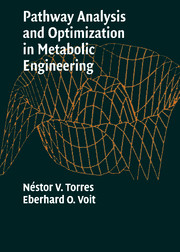Book contents
- Frontmatter
- Contents
- Preface
- 1 Target: A Useful Model
- 2 Methods of Biochemical Systems Theory
- 3 A Model of Citric Acid Production in the Mold Aspergillus niger
- 4 Optimization Methods
- 5 Optimization of Biochemical Systems
- 6 Optimization of Citric Acid Production in Aspergillus niger
- 7 Maximization of Ethanol Production in Saccharomyces cerevisiae
- 8 Conclusions
- Author Index
- Subject Index
- Plate section
- References
1 - Target: A Useful Model
Published online by Cambridge University Press: 28 July 2009
- Frontmatter
- Contents
- Preface
- 1 Target: A Useful Model
- 2 Methods of Biochemical Systems Theory
- 3 A Model of Citric Acid Production in the Mold Aspergillus niger
- 4 Optimization Methods
- 5 Optimization of Biochemical Systems
- 6 Optimization of Citric Acid Production in Aspergillus niger
- 7 Maximization of Ethanol Production in Saccharomyces cerevisiae
- 8 Conclusions
- Author Index
- Subject Index
- Plate section
- References
Summary
CRITERIA FOR MODEL SELECTION
Before we get lost in the technical details of manipulating functions, approximating complicated phenomena, or designing and analyzing models, it is useful to establish more clearly what exactly our target is. At a superficial level, this is easily stated. Our target is a mathematical model of the biotechnological phenomenon of interest, and this model should be valid, yet convenient for analysis, manipulation, and optimization. Once we have such a model, we can screen hypotheses and perform test runs on the computer, which is much faster and cheaper than implementing and executing the actual experiments in the lab.
While the target is obvious, the difficulty is that no unique, optimal model entirely satisfies all items on our wish list. Why is that? The complications begin with the question of validity. What is a valid representation of a particular phenomenon? Although initially surprising, the question of validity is not something absolute. Instead, validity depends heavily on the purpose of the model analysis. A model for studying the aerodynamics of a butterfly will normally not account for the color patterns of its wings, and that is probably a valid omission. By contrast, the coloration may be crucial for ecological questions of camouflaging and predation by birds.
As a familiar, yet illustrative example, consider the growth of a bacterial population (Thornton 1922), as discussed by Lotka (1924, pp. 70–1; see Table 1.1 and Figure 1.1).
- Type
- Chapter
- Information
- Publisher: Cambridge University PressPrint publication year: 2002



